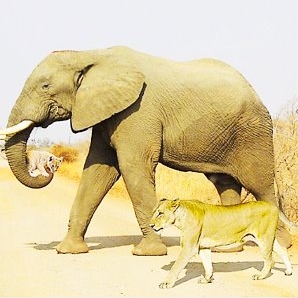
Lifestyle/Community

Going viral with a beautiful but fake post
SAM ANCER
You do so even when the post was created at 09:00 on April 1, and bears a caption explaining that the lioness had carried her cub for two kilometres and began to feel tired. Seeing the distressed lioness, an elephant picked up the cub in its trunk and carried it for her.
This beautiful photo-story was posted by Latest Sightings – Kruger, a page for a wildlife location app created by Nadav Ossendryver in 2011. The post went viral, resulting in about 60 000 shares and reaching more than 20 million people. The only problem with it was that it was fake.
The story and picture were fabricated by Ossendryver as part of an annual April Fool’s Day tradition. Only this time, the prank elicited a massive response.
For Ossendryver, the goal behind his annual April Fool’s pranks was always to start a conversation. To achieve this, he needed to create a good story.
In previous years, he says, the pranks had been fairly nonsensical, with tigers hunting narwhals or a leopard cub nursing on a male lion. This time, though, Ossendryver planned a way to get maximum engagement.
First, he focused on two of the most popular African animals: lions and elephants. Next, he created a compelling and touching narrative that would guarantee a reaction. He then curated an exact balance with the Photoshopped image. He did what he needed to do to make it good enough to seem plausible but easily identifiable as fake under scrutiny.
Finally, Latest Sightings – Kruger engaged with those who commented, making sure that others would want to interact.
Another important factor was timing. It was a scheduled post, released to the online world at 9am on a public holiday. This ensured maximum visibility among all social media platforms, allowing the post to gain many “Shares” on Facebook.
Ossendryver cited another reason for the post’s broad appeal on Twitter: the existence of so-called black Twitter, whose adherents retweeted the post and engaged with their followers about the joke.
It is clear from the comments posted online that Ossendryver got exactly what he wanted. Many Facebook followers were determined to uncover the facts behind the photo; they analysed shadows, backtracked the images to their original source and worked out that the person who took the photo under the name Lirpa Sloof was, in fact, April Fool’s spelt backwards.
Others either admitted to being duped or made jokes about it, such as this commentator: “The tragic end to this was the elephant sneezing. The cub was found 18 kilometres away.”
Although most of the people who commented were able to identify the image as a fake, several mainstream news outlets asked Ossendryver if he had video footage they could purchase.
The prank was also a great feat in guerrilla marketing – an advertising concept whereby businesses promote their products or services in an unconventional way, with little budget to spend. It gained Latest Sightings – Kruger thousands of followers on Facebook and Twitter.
However, the intention of the prankster was clear – to make people laugh and have a good time joking around on April Fool’s Day.
It will be interesting to see what Latest Sightings – Kruger will do to top this.





Ilmu Komunikasi
August 27, 2023 at 12:58 pm
Could you explain why posts like the one you mentioned, even those created on April 1 with captions describing a lioness and elephant’s interaction, continue to receive engagement and reactions on your platform? How do you handle posts that might contain fictional or misleading content?